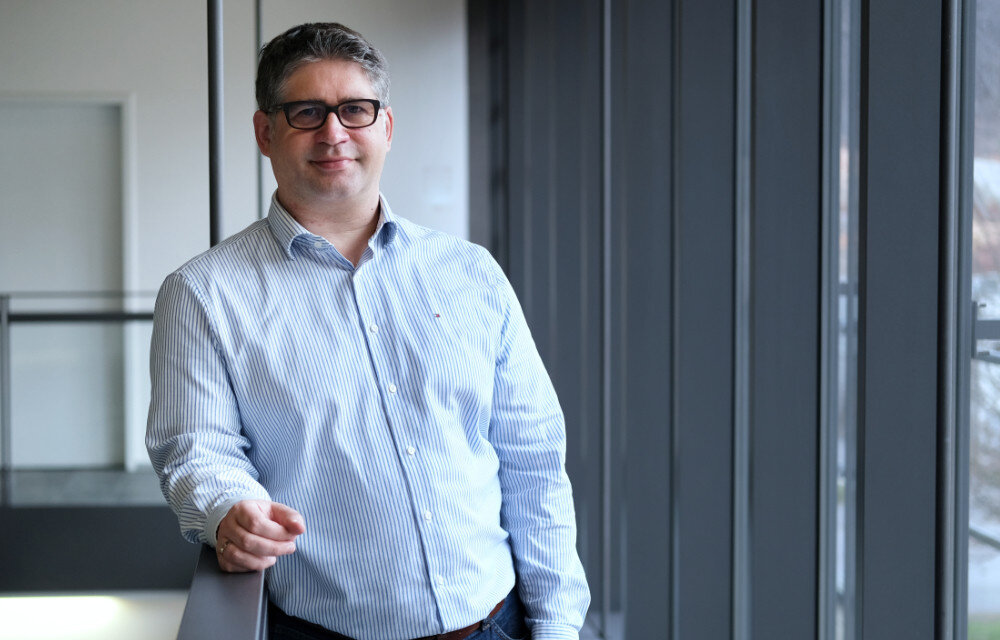Personal genome printed on more than 300,000 pages: Artist cooperates with Saarbrücken bioinformatician

Saarland University bioinformatics professor Sven Rahmann. Foto: SIC/Philipp Zapf-Schramm
View all images
The Berlin-based artist Alicja Kwade had her personal genome printed out for her exhibition “In Absence” – on 314,000 DIN A4 pages of paper. To do this, she collaborated with Sven Rahmann, bioinformatics professor at Saarland University. The exhibition can be visited at the Berlinische Galerie until April 4.
The human genome consists of 3.1 billion base pairs – a number that is difficult to grasp. “Even for us bioinformaticians, this is an abstractly high number, although we work with genome data almost every day. This is because we usually only have the data as files on the computer,” says Saarbrücken bioinformatics professor Sven Rahmann.
The dimensions of the human genome can be better understood through a project by the Berlin artist Alicja Kwade. She has had her personal genome printed out on 314,000 A4 pages and is exhibiting it publicly in her exhibition “In Absence” at the Berlinische Galerie. 12,000 pages have been hung on the walls of the hall, the rest are in copper archive boxes distributed around the room. If all the pages of this genome document were laid side by side, they would stretch over a length of around 66 kilometers.
One aspect of the art project was to highlight which parts of the genome are unique to the artist – because basically, all people’s DNA is 99.9 percent the same. This is where the Saarbrücken bioinformaticians came in: “The collaboration with Alicja Kwade came about through a mutual acquaintance, Dr. Frank Tschentscher, an expert for DNA analyses at the NRW State Criminal Police Office. He generated the genome data for the artist and then looked for a qualified expert to analyze this data. This is how he came across me; we both did research at the University of Duisburg-Essen. My contribution to the art project consisted specifically of using methods of bioinformatics analysis to identify the genome sections unique to Alicja Kwade and highlighting them in bold in a print-ready document,” says Sven Rahmann. The end result were several hundred PDF documents, each with 480 pages: “That was the maximum length per document that the print shop could handle. We also had to find that out through testing first,” says Rahmann.
But how does one actually print a genome? Professor Sven Rahmann explains: “To describe the sequence of base pairs in the genome, the four bases of DNA, i.e. adenine, cytosine, guanine and thymine, are coded with the letters A, C, G and T in the so-called ‘alphabet of life’. A complete genome can thus be reproduced as a 3.1 billion-character sequence of these letters and thus also be printed.”
Even for the professor, who has been working on bioinformatics problems and specifically the analysis of individual genome variants for almost 25 years, it was something special to be involved in the art project. “To my knowledge, it is the first time in the world that a human genome has been physically printed in this form. This has also made it possible for me to experience the genome on a completely new level. There may well be a few thousand letters between two bold printed positions, which are the same for all of us. To see so clearly in front of you how much we humans are alike, regardless of our origins, conveys a strong message. I imagine this to be particularly impressive in the exhibition, where an entire hall is papered with ‘genome pages’. Unfortunately, I was not yet able to be on site in Berlin myself because of Corona,” says Saarbrücken bioinformatics professor Sven Rahmann.
Further Information:
https://berlinischegalerie.de/ausstellung/alicja-kwade/
https://www.rahmannlab.de/index.html
Questions can be directed at:
Prof. Dr. Sven Rahmann
rahmann@cs.uni-saarland.de
+49 (681) 302-70880
Background Saarland Informatics Campus:
900 scientists (including 400 PhD students) and about 2100 students from more than 80 nations make the Saarland Informatics Campus (SIC) one of the leading locations for computer science in Germany and Europe. Five world-renowned research institutes, namely the German Research Center for Artificial Intelligence (DFKI), the Max Planck Institute for Informatics, the Max Planck Institute for Software Systems, the Center for Bioinformatics and the Cluster for “Multimodal Computing and Interaction” as well as Saarland University with three departments and 24 degree programs cover the entire spectrum of computer science.
Editor:
Philipp Zapf-Schramm
Competence Center Computer Science
Saarland Informatics Campus
Phone: +49 681 302-70741
E-Mail: pzapf@mmci.uni-saarland.de
Press photos for download for use free of charge in connection with this press release:
Die Öffentlichkeitsarbeit am Saarland Informatics Campus wird unterstützt durch das Kompetenzzentrum Informatik Saarland, gefördert aus Mitteln des Europäischen Fonds für regionale Entwicklung (EFRE) und Mitteln der Staatskanzlei Saarland.



